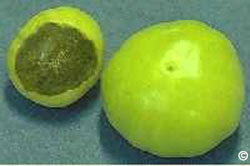What is blossom end rot?
 Blossom end rot, or BER for short, is a complex physiological disorder that is caused by a calcium (Ca) deficiency. Calcium is not very mobile within the plant and it is required in relatively large amounts when the fruit is rapidly growing. If demand for calcium exceeds supply, tissues lacking this mineral break down leaving a characteristic leathery, brown to black area on the blossom end of fruit such as tomato, pepper, squash, eggplant and watermelon.
Blossom end rot, or BER for short, is a complex physiological disorder that is caused by a calcium (Ca) deficiency. Calcium is not very mobile within the plant and it is required in relatively large amounts when the fruit is rapidly growing. If demand for calcium exceeds supply, tissues lacking this mineral break down leaving a characteristic leathery, brown to black area on the blossom end of fruit such as tomato, pepper, squash, eggplant and watermelon.
When does blossom end rot occur?
In Colorado, BER normally occurs in the first fruit set of the season. It is most common when the growing season starts out wet then becomes dry when fruit it setting. Damage first appears when fruits are approximately half their full size. When BER appears, the fruit should be picked and properly discarded.
Factors leading to the development of BER include:
- sharp changes in temperature from cool to hot weather
- extreme temperature fluctuation
- drought stress
- waterlogged soils (i.e. over irrigation or too much rain)
- excessive growth due to too much nitrogen fertilization
- root damage due to deep cultivation or disease
Management considerations:
- adequately prepare garden bed prior to planting. Insure proper draining soil in the bed by added needed amendments, maintain soil pH around 6.5
- once the problem develops, quick fixes are difficult. Stabilize the moisture level as much as possible; poorly drained soils cause roots to “smother” leading to reduced Ca uptake
- after planting, avoid deep cultivation that can damage plant roots
- maintain even soil moisture by using mulches – plants generally use 1” of moisture per week
- avoid excess nitrogen fertilizers
For more information, see the following Colorado State University Extension fact sheet(s).
For more information, see the following Planttalk Colorado™ script(s).



